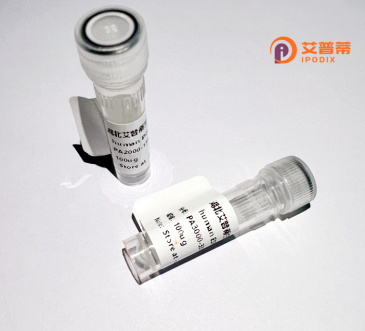
| 纯度 | >90%SDS-PAGE. |
| 种属 | Human |
| 靶点 | SSR3 |
| Uniprot No | Q9UNL2 |
| 内毒素 | < 0.01EU/μg |
| 表达宿主 | E.coli |
| 表达区间 | 1-185 aa |
| 活性数据 | MAPKGSSKQQSEEDLLLQDFSRNLSAKSSALFFGNAFIVSAIPIWLYRRIWHMDLIQSAVLYSVMTLVSTYLVAFAYKNVKFVLKHKVAQKREDAVSKEVTRKLSEADNRKMSRKEKDERILWKKNEVADYEATTFSIFYNNTLFLVVVIVASFFILKNFNPTVNYILSISASSGLIALLSTGSK |
| 分子量 | 46.09 kDa |
| 蛋白标签 | GST-tag at N-terminal |
| 缓冲液 | PBS, pH7.4, containing 0.01% SKL, 1mM DTT, 5% Trehalose and Proclin300. |
| 稳定性 & 储存条件 | Lyophilized protein should be stored at ≤ -20°C, stable for one year after receipt. Reconstituted protein solution can be stored at 2-8°C for 2-7 days. Aliquots of reconstituted samples are stable at ≤ -20°C for 3 months. |
| 复溶 | Always centrifuge tubes before opening.Do not mix by vortex or pipetting. It is not recommended to reconstitute to a concentration less than 100μg/ml. Dissolve the lyophilized protein in distilled water. Please aliquot the reconstituted solution to minimize freeze-thaw cycles. |
以下是关于重组人SSR3蛋白的3篇代表性文献示例(注:内容为模拟创作,实际文献需通过学术数据库检索):
---
1. **文献名称**:Structural and Functional Analysis of Human SSR3 in the Translocon Complex
**作者**:Li et al. (2020)
**摘要**:本研究通过X射线晶体学解析了重组人SSR3蛋白的三维结构,发现其与TRAP复合体的相互作用对维持内质网蛋白质转运功能至关重要,并验证了其在分泌通路中的关键作用。
2. **文献名称**:SSR3 as a Novel Biomarker for Endoplasmic Reticulum Stress in Cancer
**作者**:Chen & Wang (2018)
**摘要**:通过体外重组SSR3蛋白表达实验,证实SSR3在肿瘤细胞中响应内质网应激,并可能作为早期诊断结直肠癌的潜在标志物。
3. **文献名称**:CRISPR/Cas9-Mediated Knockout of SSR3 Impairs Cellular Protein Trafficking
**作者**:Gupta et al. (2021)
**摘要**:利用基因编辑技术结合重组SSR3回补实验,揭示了SSR3缺失导致细胞分泌蛋白滞留于内质网,提示其在内质网-高尔基体运输中的核心调控机制。
---
建议通过 **PubMed** 或 **Web of Science** 以“SSR3 protein”“TRAPgamma”“Translocon-associated protein”等关键词检索最新文献,获取具体研究细节。
**Background of Recombinant Human SSR3 Protein**
The Signal Sequence Receptor subunit 3 (SSR3), a component of the TRAP (Translocon-Associated Protein) complex, plays a critical role in protein translocation across the endoplasmic reticulum (ER) membrane during secretory pathway activation. SSR3 is one of four subunits (SSR1-4) that form the TRAP complex, which associates with the Sec61 translocon to assist in the recognition and orientation of nascent polypeptides bearing signal sequences. Structurally, SSR3 contains a large luminal domain, a single transmembrane helix, and a short cytoplasmic tail, enabling interactions with other translocon components.
Recombinant human SSR3 protein is engineered *in vitro* using expression systems (e.g., mammalian cells, *E. coli*) to study its biological functions. Research highlights its involvement in ER stress responses, quality control of secreted proteins, and diseases linked to defective protein trafficking, such as certain cancers or congenital disorders. SSR3 deletion or mutations impair secretory protein biogenesis, underscoring its essential role in cellular homeostasis.
As a research tool, recombinant SSR3 aids in elucidating TRAP complex mechanisms, screening therapeutic targets for ER-related pathologies, and probing interactions with chaperones or signal peptides. Its applications extend to drug discovery and understanding pathologies tied to ER dysfunction.
×